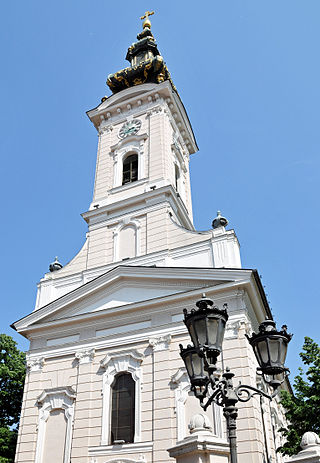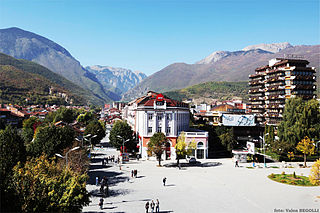
The Serbian Orthodox Church is one of the autocephalous Eastern Orthodox Christian churches.

The Bajrakli Mosque is a mosque in Belgrade, the capital of Serbia. It is located in Gospodar Jevremova Street in the neighbourhood of Dorćol. It was built around 1575, and is the only mosque in the city out of the 273 that had existed during the time of the Ottoman Empire's rule of Serbia.

The Belgrade Fortress, consists of the old citadel and Kalemegdan Park on the confluence of the Sava and Danube rivers, in an urban area of modern Belgrade, Serbia. Located in Belgrade's municipality of Stari Grad, the fortress constitutes the specific historical core of the city. As one of the most important representatives of Belgrade's cultural heritage, it was originally protected right after World War II, among the first officially declared cultural monuments in Serbia. The fortress was declared a Monument of Culture of Exceptional Importance in 1979, and is protected by the Republic of Serbia. It is the most visited tourist attraction in Belgrade, with Skadarlija being the second. Since the admission is free, it is estimated that the total number of visitors is over 2 million yearly.

The Church of Saint Sava is a Serbian Orthodox church which sits on the Vračar plateau in Belgrade, Serbia. It was planned as the bishopric seat and main cathedral of the Serbian Orthodox Church. The church is dedicated to Saint Sava, the founder of the Serbian Orthodox Church and an important figure in medieval Serbia. It is built on the presumed location of St. Sava's grave. His coffin had been moved from Mileševa Monastery to Belgrade. The coffin was placed on a pyre and burnt in 1595 by Ottoman Grand Vizier Sinan Pasha. Bogdan Nestorović and Aleksandar Deroko were finally chosen to be the architects in 1932 after a second revised competition in 1926–27. This sudden decision instigated an important debate in interwar Yugoslavia which centered around the temple's size, design and symbolic national function. This was accompanied by a sizeable increase in the base area of the ambitiously conceived project. The new design departed from the competition guidelines issued in 1926, and was to replicate the dimensions and architecture of Hagia Sophia.

Neo-Byzantine architecture was a revival movement, most frequently seen in religious, institutional and public buildings. It incorporates elements of the Byzantine style associated with Eastern and Orthodox Christian architecture dating from the 5th through 11th centuries, notably that of Constantinople and the Exarchate of Ravenna.
Modern-day Birmingham's cultural diversity is reflected in the wide variety of religious beliefs of its citizens. In the 2021 census, 70% of residents identified themselves as belonging to a particular faith, while 24% stated they had no religion and a further 6% did not answer the question.

The dominant religion in Vojvodina is Orthodox Christianity, mainly represented by the Serbian Orthodox Church, while other important religions of the region are Catholic Christianity, Protestant Christianity, Islam, and Judaism.

Ružica Church is a Serbian Orthodox church located in the Belgrade Fortress, in Belgrade, the capital of Serbia. The original church was built in the early 15th century. It was remodelled in 1869 and fully reconstructed in 1925. It is dedicated to the Nativity of Mary. With its location within the fortress near the water spring of Saint Petka, constant crowds of visitors come - especially on Saint Petka's feast day. It is considered one of the "best loved churches among the faithful".

The conversion of non-Islamic places of worship into mosques occurred during the life of Muhammad and continued during subsequent Islamic conquests and invasions and under historical Muslim rule. Hindu temples, Jain Temples, churches, synagogues, and Zoroastrian fire temples have been converted into mosques.

Religious architecture in Novi Sad is very diverse. Majority of the believers in Novi Sad are from Serbian Orthodox Church, while others are from Roman Catholic Church, many Protestant churches, and Jewish community. Stari Grad is the place with the majority of churches and temples, and they were all built in the 18th and 19th century.

A round church is a church with a completely circular plan, thus a rotunda in architectural terms.

The architecture of Serbia has a long, rich and diverse history. Some of the major European style from Roman to Postmodern are demonstrated, including renowned examples of Raška, Serbo-Byzantine with its revival, Morava, Baroque, Classical and Modern architecture, with prime examples in Brutalism and Streamline Moderne.
Religion in Atlanta, while historically centered on Protestant Christianity, now involves many faiths as a result of the city and metro area's increasingly international population. While Protestant Christianity still maintains a strong presence in the city, in recent decades Catholic Christians have gained a strong foothold due to migration patterns. Atlanta also has a considerable number of ethnic Christian congregations, such as Korean Baptist, Methodist, and Presbyterian Churches, the Tamil Church Atlanta, Telugu Church, Hindi Church, Malayalam Church, Ethiopian, Chinese, and many more traditional ethnic religious groups. Large non-Christian faiths are present in the form of Buddhism, Judaism and Hinduism. Overall, there are over 1,000 places of worship within Atlanta.

Architecture of Belgrade is the architecture and styles developed in Belgrade, Serbia. Belgrade has wildly varying architecture, from the centre of Zemun, typical of a Central European town, to the more modern architecture and spacious layout of New Belgrade. The oldest architecture is found in Kalemegdan park. Outside of Kalemegdan, the oldest buildings date only from 19th century, due to its geographic position and frequent wars and destructions. The oldest public structure in Belgrade is a nondescript Turkish türbe, while the oldest house is a modest clay house on Dorcol, the House at 10 Cara Dušana Street from 1727.

Saint Sava, known as the Enlightener, was a Serbian prince and Orthodox monk, the first Archbishop of the autocephalous Serbian Church, the founder of Serbian law, and a diplomat. Sava, born as Rastko Nemanjić, was the youngest son of Serbian Grand Prince Stefan Nemanja, and ruled the appanage of Zachlumia briefly in 1190–92. He then left for Mount Athos, where he became a monk with the name Sava (Sabbas). At Athos he established the monastery of Hilandar, which became one of the most important cultural and religious centres of the Serbian people. In 1219 the Patriarchate exiled in Nicea recognized him as the first Serbian Archbishop, and in the same year he authored the oldest known constitution of Serbia, the Zakonopravilo nomocanon, thus securing full religious and political independence. Sava is regarded as the founder of Serbian medieval literature.

The architecture of Peja, Kosovo, describes a large mixture of architectural structures which are a reflection of the influential foreign rule all across the city. The architecture of the city consists of buildings, structures and constructions which were built with an architectural influence of the Byzantine architecture, Serbo-Byzantine architecture, Ottoman architecture, Stalinist architecture, and Modern cultures/architectures. Because of this there are many churches, mosques, buildings which are attraction points in the city and were built by the aforementioned influences. The rule of the Ottoman and Serbian empires and the historical influence of former Yugoslavia have shaped the architectural landscape of the city to become a conglomerate of cultures.

The Cathedral of the Blessed Virgin Mary also called the Catholic Cathedral of Belgrade is since 1988 the cathedral church of the Roman Catholic Archdiocese of Belgrade. It is located at 75 Hadži Milentijeva Street in the Belgrade's neighborhood of Neimar, in the municipality of Vračar.

The Building of the Patriarchate is a building in Belgrade, the capital of Serbia. It is the administrative seat of the Serbian Orthodox Church and its head, the Patriarch of the Serbian Orthodox Church. Finished in 1935, the building was declared a cultural monument on 18 December 1984.

Lavrentije Trifunović was a Serbian Orthodox bishop. He was the Bishop of Šabac between 2006 and his death. Formerly, he was Bishop of Šabac and Valjevo (1989–2006), Bishop of Western Europe (1973–1989), Bishop of Western Europe and Australia (1969–1973) and Vicar Bishop of Moravica (1967–1969). Lavrentije spoke English, German and Russian. He was a member of the Holy Synod of Bishops between 2002 and 2004.
















